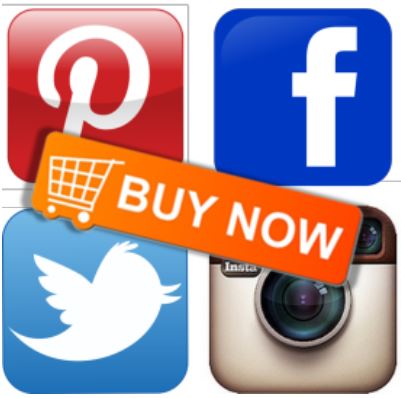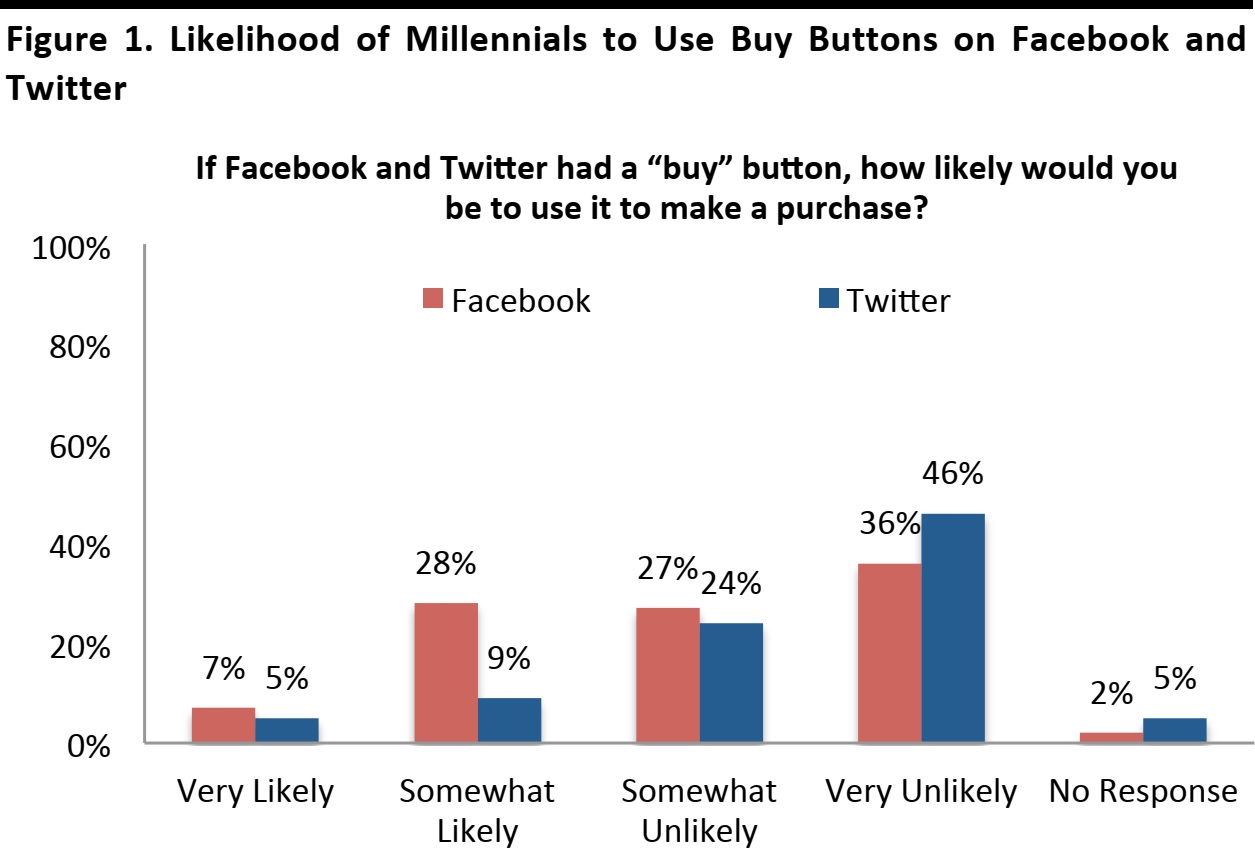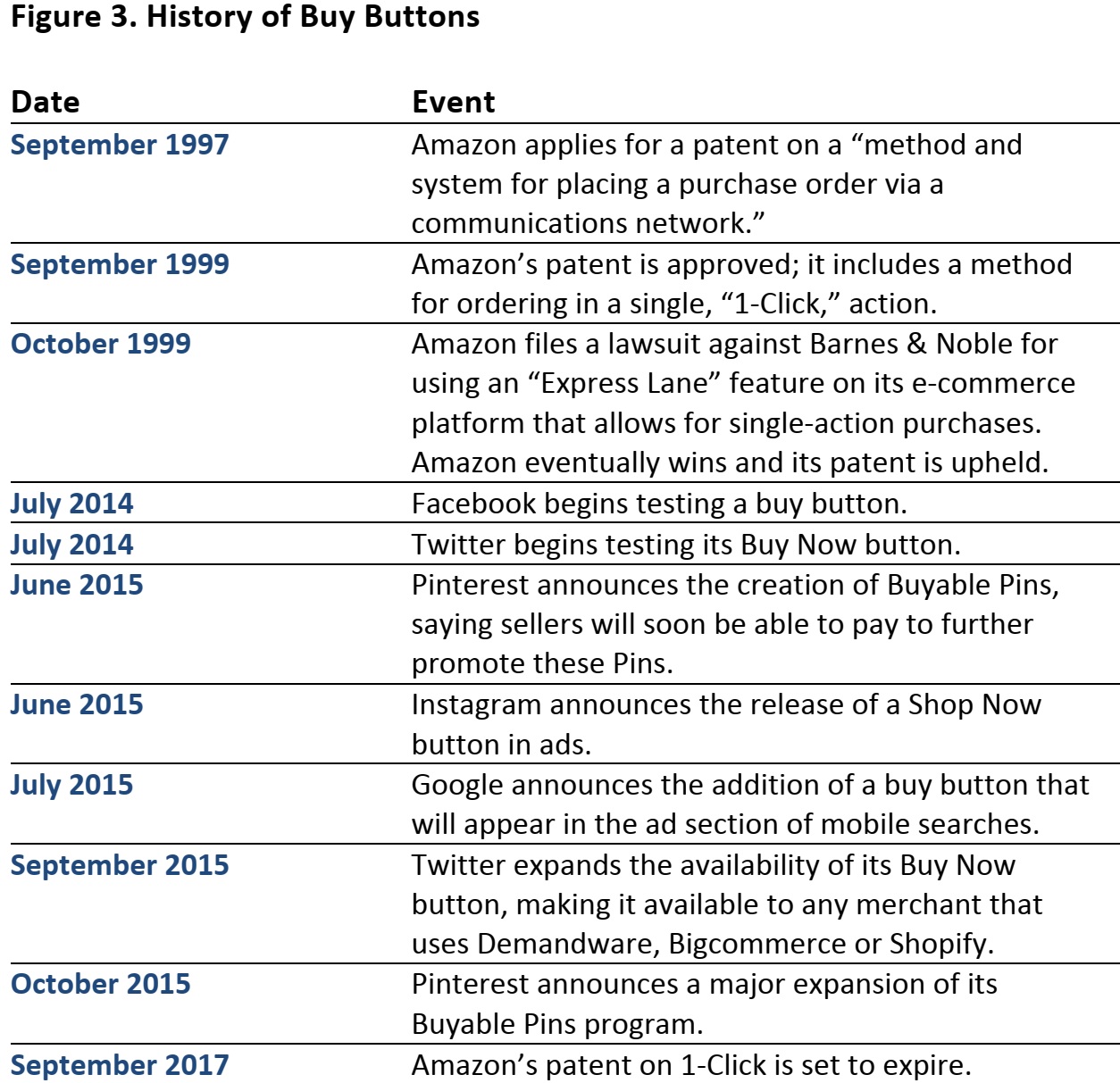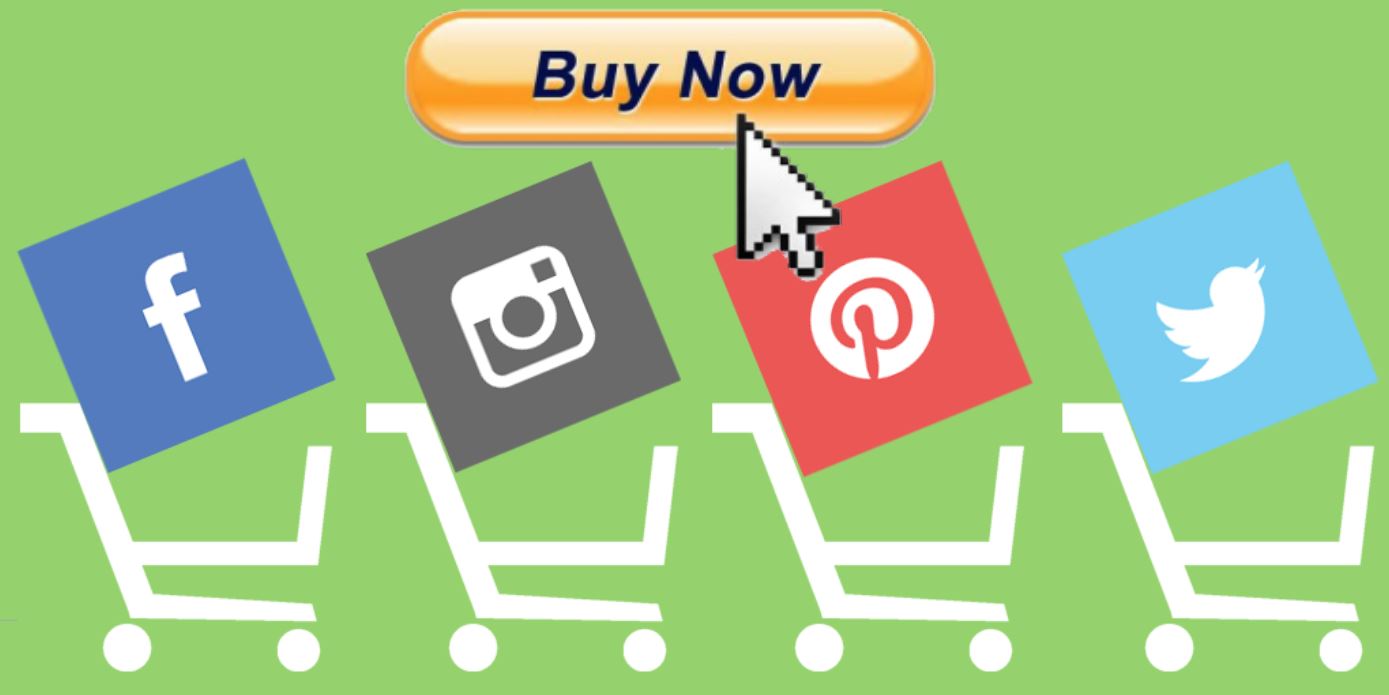 EXECUTIVE SUMMARY
EXECUTIVE SUMMARY
Buy buttons are not brand new—Amazon patented a version of one way back in 1999—and in recent years, they have proliferated on social media; most major platforms have tested them in some form. With a few exceptions, though, buy button technology has not been widely adopted by platforms that were not traditionally used for e-commerce. Consumer adoption has also been slow, although quantitative data on buy button usage is scarce. However, there is a major need to make shopping on mobile devices easier, so as companies continue to test these buttons, and as new entrants disrupt the space, buy buttons have the potential to change the face of e-commerce.
WHAT IS A BUY BUTTON?
A buy button is simply a responsive button or clickable link that is embedded into either a web page or social media network in order to enable e-commerce. Clicking the button allows the site or app visitor to directly purchase a product or service without having to go to a separate retailer’s site or payment service. Increasingly, social media platforms are testing such buttons, although different platforms refer to them by different names. For example, Instagram now has a series of call-to-action buttons, labeled “Shop Now,” “Install Now,” “Sign Up” and “Learn More.” On Pinterest, users can click a “Buy it” button on pages that are called Buyable Pins. Regardless of their names, the buy buttons all serve the same basic purpose—and their effectiveness is still to be seen.
A 2014 study by researchers at the University of Massachusetts Dartmouth that focused solely on millennials shed some light on their willingness to use buy buttons. The researchers surveyed a diverse group of 405 millennials, ages 14–33, and found that 35% of those surveyed are likely to use a buy button on Facebook and 24% are likely to use a buy button on Twitter.

Source: University of Massachusetts Dartmouth Survey
DRIVING FORCES
There are three main ideas driving buy button adoption: increased use of mobile devices, shopping cart abandonment and the serendipity of shoppers finding additional items they were not originally searching for.
Mobile device users tend to prefer apps to websites, as small screens and poorly optimized websites can make it difficult and time consuming to navigate between different apps and websites on a mobile device. This difficulty makes mobile shopping a frustrating experience for some, and presents an opportunity for retailers that incorporate buy buttons into their apps.
Another challenge that buy buttons can help alleviate is shopping cart abandonment. The online retail market was worth approximately $1.6 trillion in 2015, according to eMarketer. However, shoppers filled up their online carts with an estimated $4 trillion worth of goods and services that they later abandoned without purchasing. The graph below, based on a 2012 Worldpay survey of 19,000 consumers, illustrates that shoppers abandon their online carts for a variety of reasons other than price concerns, including difficulties during the checkout process and concerns about security.

Source: Worldpay
A third factor driving buy button adoption is that the buttons can increase impulse buying online. Most brick-and-mortar retailers already rely on impulse purchases to increase sales. But buy buttons have the potential to increase such serendipitous purchasing online, by helping shoppers find and purchase items that they were not necessarily searching for.

Source: US Patent and Trademark Office/company press releases
KEY PLAYERS
Amazon
Increasing adoption of buy buttons means that Amazon, the longtime leader in the online retail space, is facing competition from companies that were not typically seen as e-commerce players. In 2014, Amazon attempted to increase its social media presence by running a trial program with Twitter. The program, which was later canceled, enabled users to automatically add products to their cart by tweeting #amazoncart in reply to Amazon shopping links.

eBay

eBay has a Buy It Now feature available for many products, enabling users to immediately purchase an item rather than going through the auction process that the site is known for.
Facebook
Facebook is still in the process of testing its buy button and has not yet made it widely available. The test is limited to a few small and medium-sized US businesses. The buy button can be found in News Feed ads, and it enables the user to click to purchase an item without having to leave the site. Facebook also now has a shopping section available for business pages; businesses can choose to either link directly to their retail site or, as Facebook says, “test a way for people to buy directly on their Pages.”

Google
Google has created a function that it is calling “Purchases on Google.” It enables the user to click on a product ad and be taken to a microsite within Google that has the look and feel of the retailer, helping the retailer maintain its relationship with the customer. The customer can then buy the product from that microsite or search for other products from the same company.

 Instagram
Instagram
Instagram is currently testing buy buttons within ads, although only in Spain. The site has introduced a series of call-to-action buttons with embedded links that lead users to product purchasing information and other kinds of information. These buttons include “Shop Now,” “Install Now,” “Sign Up” and “Learn More.”
Pinterest
Pinterest is perhaps the leader in using buy buttons on a social media platform, and millions of products are now available via the company’s Buyable Pins functionality. Users tend to visit Pinterest to view images of products that they desire or want to purchase rather than to socialize with others, as is the case on most social media platforms. Compared to regular Pins, Buyable Pins have been shown to more than double sales conversion rates. Unlike many other key players that use buy buttons, Pinterest has released early results on a few of its small retailers’ efforts. Online clothing retailer Spool No.72 reported that 84% of the customers that came through its Buyable Pins pages were new. Another e-tailer, Madesmith, reported that Buyable Pins accounted for about 7% of its sales.

Shopify
Shopify is a leading e-commerce platform that enables users to embed buy buttons on their own websites. Through a partnership with Twitter, all Shopify customers can also use a Buy Now button on Twitter.
Twitter
Twitter’s simple Buy Now button allows users to purchase products with two clicks: the first click is on the Buy Now button and the second click confirms the purchase. First-time users of the button need to go through a process of providing payment and shipping information.
YouTube
YouTube goes one step further than just allowing users to directly purchase from retailer-produced videos and advertisements: advertisers can also place buy buttons in other people’s videos, as long as the videos’ uploaders opt in to the service. For example, a retailer can put a buy button into fan-made “unboxing” videos that show fans taking products they have purchased out of the box while they provide commentary.

DISRUPTORS
Keep

The Keep app is a curated shopping platform that helps users find products that are trending across e-commerce sites. Keep’s OneCart feature acts as a universal shopping cart to address issues of cart abandonment. It allows Keep users to choose products from any online store and add them to a single cart. After they have finished going through all the stores they want to visit, they can check out with just one more click. For example, a shopper can order a shirt from American Eagle Outfitters, a sofa from IKEA and a band saw from Home Depot without having to input his or her payment information and check out three separate times.

Two Tap is a startup billing itself as “the first e-commerce gateway enabling online shopping everywhere with just a few taps.” It provides retailers with a buy button that can be embedded into content sites such as blogs and magazines to enable consistent shopping experiences that were not previously available.
POTENTIAL CHALLENGES
One risk of using buy buttons is that they may actually prove too successful for their own good. If retailers see that the technology leads to huge sales increases, then the buttons may also lead to increasing numbers of ads being shown on social media. This, in turn, may drive away users who do not wish to be marketed to so heavily on social platforms and those same customers that companies were trying to reach via the ads.
LOOKING FORWARD
The growth potential of buy buttons is underpinned by three factors: awareness levels are currently low, but growing; the buttons can make mobile shopping easier and more convenient; and Amazon’s patent on its “1-Click” technology is set to expire, which will open the door for other retailers to create their own one-click buy buttons.
According to market analysis firm Custora, social media channels accounted for only 1.8% of online sales during the 2015 holiday season, compared to 1.9% in 2014. Michael Yamartino, Head of Commerce at Pinterest, notes that this low share of sales is partially attributable to a lack of awareness about and knowledge of buy buttons. Buy buttons are still new, and there are only a limited number of items available for purchase through them—meaning that many shoppers may not have had a reason to actually try them yet. Also, the mobile device conversion gap is likely to narrow as more social platforms adopt buy buttons, since they alleviate the hassle of checking out on a small screen, which shoppers frequently say is a main reason they avoid mobile shopping. Finally, in September 2017, Amazon’s “1-Click” patent will expire, opening the door for other companies to create buy buttons that operate with one click, which could eventually lead to more seamless purchases across the board.
CONCLUSION
Most major social media platforms have already either tested or implemented buy buttons, but the buttons have yet to be employed widely, and adoption by consumers has also been slow. However, the buttons have the potential to change the face of e-commerce if they are used effectively, especially if they address the difficulties of shopping on mobile devices and shopping cart abandonment. E-commerce disruptors such as Keep and Two Tap, with their universal shopping-cart functionality, and the expiration of Amazon’s 1-Click patent in 2017 are likely to cause even more changes in this space.

 EXECUTIVE SUMMARY
EXECUTIVE SUMMARY




 Instagram
Instagram

 The Keep app is a curated shopping platform that helps users find products that are trending across e-commerce sites. Keep’s OneCart feature acts as a universal shopping cart to address issues of cart abandonment. It allows Keep users to choose products from any online store and add them to a single cart. After they have finished going through all the stores they want to visit, they can check out with just one more click. For example, a shopper can order a shirt from American Eagle Outfitters, a sofa from IKEA and a band saw from Home Depot without having to input his or her payment information and check out three separate times.
The Keep app is a curated shopping platform that helps users find products that are trending across e-commerce sites. Keep’s OneCart feature acts as a universal shopping cart to address issues of cart abandonment. It allows Keep users to choose products from any online store and add them to a single cart. After they have finished going through all the stores they want to visit, they can check out with just one more click. For example, a shopper can order a shirt from American Eagle Outfitters, a sofa from IKEA and a band saw from Home Depot without having to input his or her payment information and check out three separate times.


